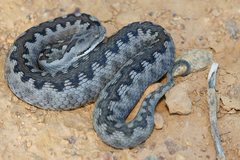Mediterranean house gecko
Hemidactylus turcicus
Hemidactylus turcicus, commonly known as the Mediterranean House Gecko, is a small to medium-sized species of lizard belonging to the family Gekkonidae. This reptile is widely distributed across the Mediterranean region and is often found in urban and suburban environments.
Characteristics:
- Typically, the Mediterranean House Gecko measures between 7.5 and 15 cm in total length.
- It has a soft, translucent skin with a color that ranges from light gray to pale pink, often adorned with darker spots or mottling.
- The gecko's body is slender with large eyes, adapted for its nocturnal lifestyle.
- A characteristic feature is its adhesive toe pads, which allow it to climb smooth and vertical surfaces easily.
Habitat:
- This species is commonly found in human habitations, taking advantage of the warmth and shelter provided by buildings.
- It also inhabits rocky areas and stone walls in rural settings.
Behavior and Diet:
- Hemidactylus turcicus is a nocturnal animal, becoming active after sunset.
- Its diet mainly consists of insects and other small arthropods.
- The gecko uses its excellent climbing capabilities to hunt for prey on walls and ceilings.
Reproduction:
- The breeding season occurs during the warmer months.
- Females lay small clutches of two eggs, which are deposited in secure and warm locations.
- The eggs hatch after a few weeks, with young geckos being fully independent from birth.
In the Comunidad Valenciana, the Mediterranean House Gecko, also known as "Salamanquesa", is a familiar sight, often seen clinging to walls and light fixtures in search of insects attracted to artificial lights.






